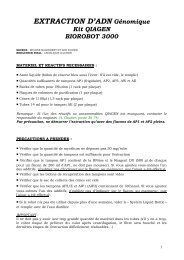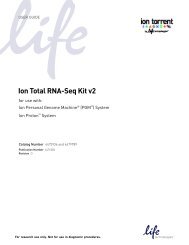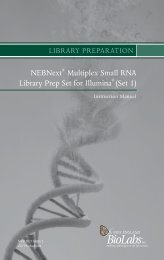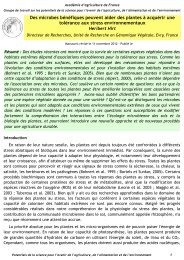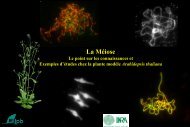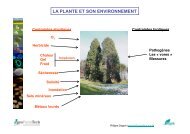The impact of Ty3-gypsy group LTR retrotransposons ... - URGV - Inra
The impact of Ty3-gypsy group LTR retrotransposons ... - URGV - Inra
The impact of Ty3-gypsy group LTR retrotransposons ... - URGV - Inra
Create successful ePaper yourself
Turn your PDF publications into a flip-book with our unique Google optimized e-Paper software.
BAC FISH data (Figure 1) and phylogenetic analysis (Figure 4). Most likely, this scenario <strong>of</strong><br />
emergence and proliferation <strong>of</strong> the genome-specific variants <strong>of</strong> retroelements in the diploid<br />
species is characteristic <strong>of</strong> the evolution <strong>of</strong> all three genomes in hexaploid wheat. <strong>The</strong> fact that<br />
over 80% <strong>of</strong> the TEs in the A- and B-genomes proliferated before the formation <strong>of</strong><br />
allopolyploid wheat also confirms this hypothesis [6]. Note that the B-genome-specific<br />
elements are not only present in the <strong>Ty3</strong>-<strong>gypsy</strong> Fatima family. In particular, in situ<br />
hybridisation <strong>of</strong> the RT fragment from Ae. speltoides Ty1-copia retroelements (RT probe) to<br />
the T. diccocoides chromosomes distinguished between the A- and B-genome chromosomes.<br />
<strong>The</strong> RT probe displayed the most intensive hybridisation to B-genome chromosomes [27].<br />
Note also the observed decrease in the efficiency <strong>of</strong> BAC FISH identification <strong>of</strong> the B-<br />
genome in allopolyploid wheat (Figure 1) compared with the diploid progenitors. This<br />
suggests that the transpositions <strong>of</strong> the <strong>gypsy</strong> <strong>LTR</strong> retrotransposon family Fatima and possibly<br />
other genome-specific TEs occurred after the formation <strong>of</strong> allopolyploids.<br />
Conclusions<br />
In this work, we performed a detailed analysis <strong>of</strong> the T. aestivum clone BAC-2383A24 and<br />
the <strong>Ty3</strong>-<strong>gypsy</strong> <strong>group</strong> <strong>LTR</strong> <strong>retrotransposons</strong> Fatima. BAC_2383A24, marked by a<br />
subtelomeric Spelt1 repeat, was localized in a distal region on the short arm <strong>of</strong> 3B<br />
chromosome using ISBP marker and the data on a synteny <strong>of</strong> wheat and rice chromosomes.<br />
Interestingly, characteristic <strong>of</strong> BAC_2383A24 is a higher gene density (one gene per 23 kb)<br />
and a lower TE content (55.6%) relative to the mean values currently determined for the<br />
wheat genome, which is in general characteristic <strong>of</strong> the distal region <strong>of</strong> the short arm <strong>of</strong> 3B<br />
chromosome [8]. Further physical mapping and sequencing <strong>of</strong> individual wheat chromosomes<br />
will clarify whether a high gene density and a lower TE content are specific features <strong>of</strong> this<br />
chromosome region only or this is also characteristic <strong>of</strong> other distal chromosome regions.




